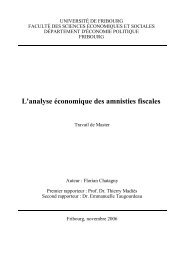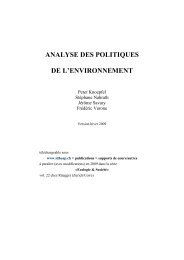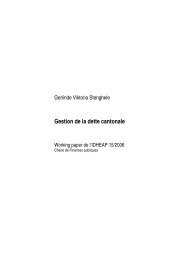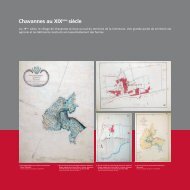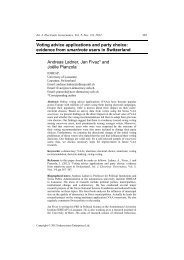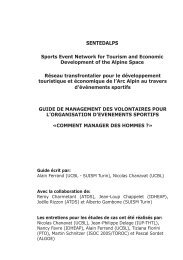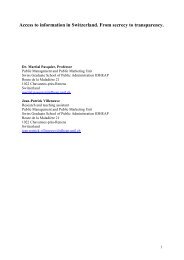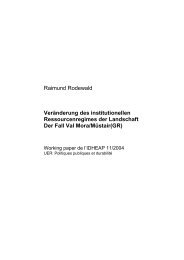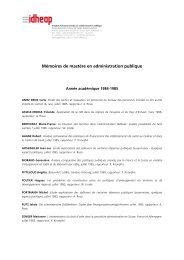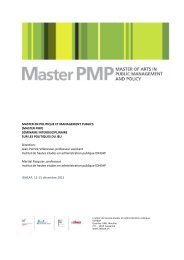Historical Analysis of Institutional Regimes in Switzerland ... - IDHEAP
Historical Analysis of Institutional Regimes in Switzerland ... - IDHEAP
Historical Analysis of Institutional Regimes in Switzerland ... - IDHEAP
Create successful ePaper yourself
Turn your PDF publications into a flip-book with our unique Google optimized e-Paper software.
11<br />
1. Exist<strong>in</strong>g property rights are hardly ever basically questioned when a regime is changed but<br />
redef<strong>in</strong>ed on an <strong>in</strong>cremental and resource-specific basis through changes <strong>in</strong> the policy design<br />
(e.g. through a change <strong>in</strong> perimeter or simple property restrictions).<br />
2. If the <strong>in</strong>terven<strong>in</strong>g protection or use policy is too weak and <strong>in</strong>capable <strong>of</strong> produc<strong>in</strong>g enough<br />
social commodities, the change <strong>in</strong> regime directly affects the regulative system (e.g. Holland:<br />
purchase <strong>of</strong> forests; Gre<strong>in</strong>a: compensation for loss <strong>of</strong> water use).<br />
3. The more differentiated and coherent a resource regime is, the more susta<strong>in</strong>able the use <strong>of</strong><br />
the resource will be, given heterogeneous demand.<br />
To summarise this heuristics, research on the historical IR change aims to exam<strong>in</strong>e when,<br />
whether, under what conditions and <strong>in</strong> what form IRs are established which can regulate all <strong>of</strong> the<br />
use demands and thus react to the grow<strong>in</strong>g scarcity <strong>of</strong> <strong>in</strong>dividual goods and services or the<br />
destruction <strong>of</strong> entire stocks <strong>of</strong> a given resource.<br />
As we previously def<strong>in</strong>ed the different types <strong>of</strong> IR, it is now also possible to identify ideal-typical<br />
historical development trajectories. Figure 2 provides an overview <strong>of</strong> such ideal-typical development<br />
paths.<br />
Figure 2: Development Trajectories <strong>of</strong> <strong>Institutional</strong> Resource <strong>Regimes</strong><br />
Degree <strong>of</strong><br />
differentiation<br />
<strong>of</strong> the resourcespecific<br />
policy design<br />
complex IR<br />
simple IR<br />
complex IR<br />
<strong>in</strong>tegrated IR<br />
No IR<br />
simple IR<br />
complex IR<br />
Degree <strong>of</strong> differentiation <strong>of</strong> the regulative system<br />
Policy-driven trajectory: This type <strong>of</strong> development trajectory means that public policies are<br />
conceived and implemented <strong>in</strong> the absence <strong>of</strong> explicit and clear property rights and their legal<br />
def<strong>in</strong>ition. It should, however, be noted that the various policy designs can def<strong>in</strong>e very well<br />
determ<strong>in</strong>ed use rights (i.e. to a few goods and services provided by the resource), even if only<br />
<strong>in</strong>directly. However, actual property rights are only clearly formulated and <strong>of</strong>ficially/legally distributed<br />
among the target groups <strong>of</strong> the relevant public policies at a later stage.<br />
Parallel trajectory: In this case, there is parallel development <strong>of</strong> property and use rights and policy<br />
design. This means that certa<strong>in</strong> property and use rights are formally def<strong>in</strong>ed and distributed while<br />
simultaneously sett<strong>in</strong>g clear limits with respect to the contents <strong>of</strong> these rights through different policy<br />
designs. The opposite situation is also plausible: if different policy designs are <strong>in</strong>troduced, this<br />
provides an opportunity to clearly def<strong>in</strong>e and distribute the formal property and use rights which are<br />
touched on by the public policies. Hence, it is not necessary to know whether the property and use<br />
rights or the policy design are the driv<strong>in</strong>g force. It is important, however, that both elements are coord<strong>in</strong>ated<br />
<strong>in</strong> terms <strong>of</strong> both form and content (like identical or Siamese tw<strong>in</strong>s).



